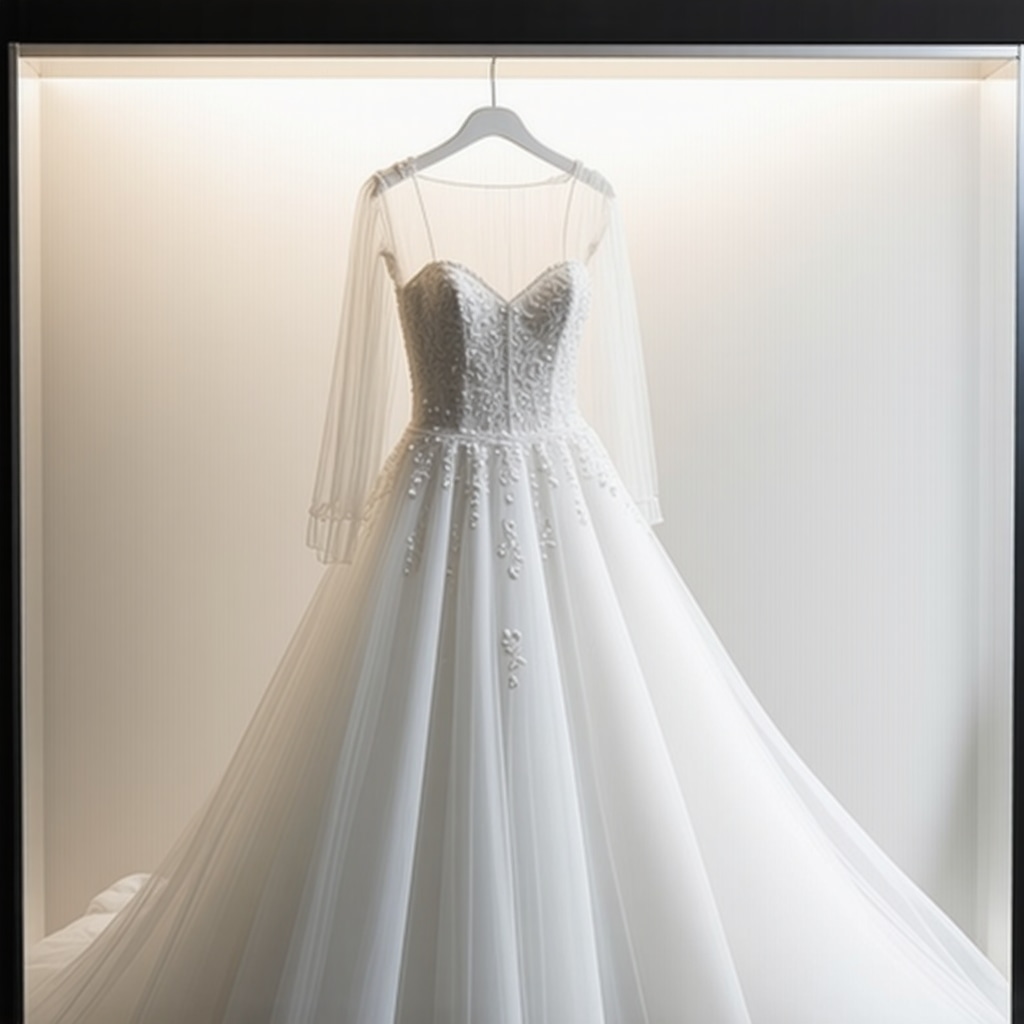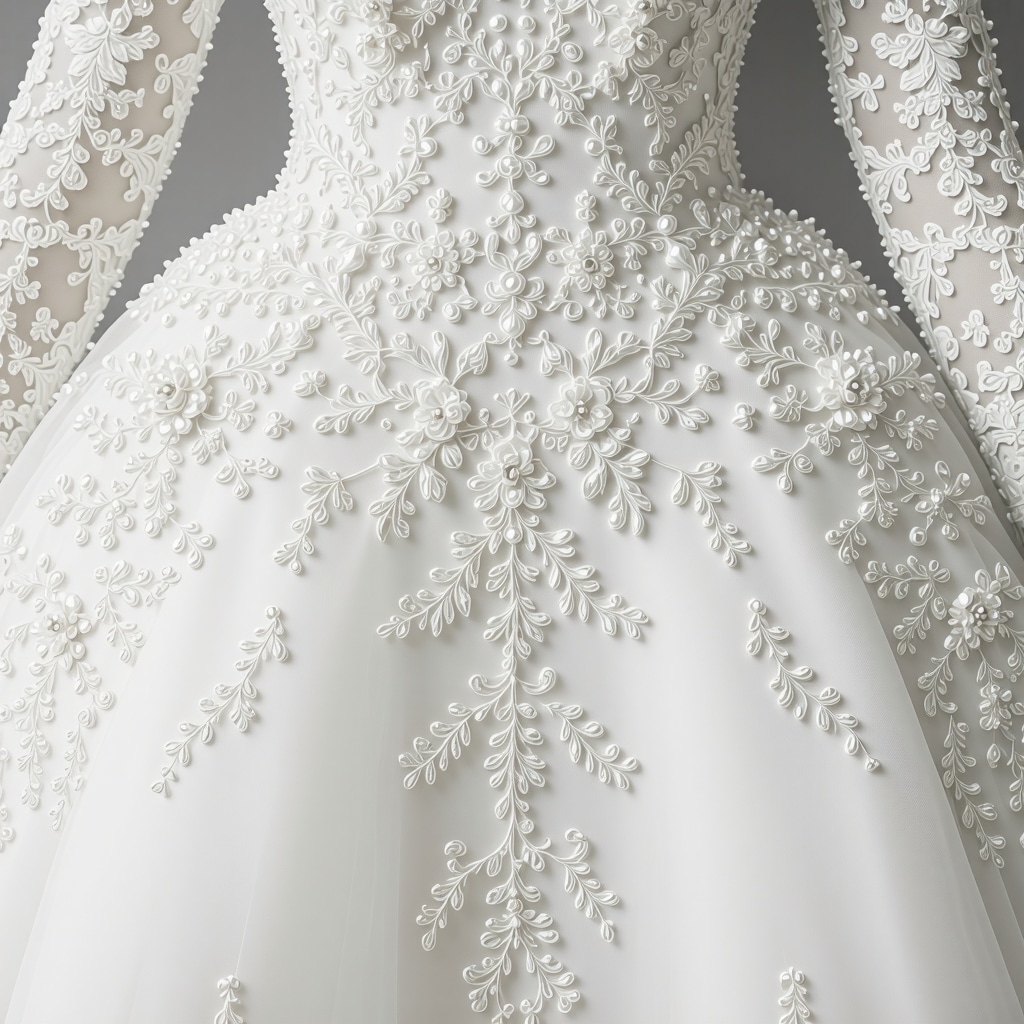Understanding the Significance of Professional Wedding Gown Preservation in Tampa
In Tampa’s humid subtropical climate, the long-term preservation of a vintage bridal gown demands specialized knowledge and meticulous care. As an industry expert, I emphasize that preservation extends beyond simple cleaning; it involves an intricate understanding of fabric behavior, environmental factors, and historical garment care techniques. This comprehensive approach ensures that your gown remains an heirloom for generations, maintaining its aesthetic and sentimental value.
How Tampa’s Climate Challenges Impact Vintage Bridal Gown Conservation
Humidity, temperature fluctuations, and exposure to light are critical factors that accelerate fabric deterioration. Tampa’s climate introduces unique challenges such as mold growth and fabric yellowing, especially in vintage textiles like silk or lace. Optimal preservation requires climate-controlled environments and specialized storage solutions that mitigate these risks, aligning with the standards outlined by the ultimate guide to wedding dress preservation in Tampa.
What Are the Advanced Techniques for Museum-Quality Gown Preservation?
Professional preservation employs techniques such as acid-free preservation boxes, silk-specific cleaning agents, and humidity control systems. These methods are designed to prevent fabric acids from causing yellowing and to reduce mold susceptibility. An expert in the field might also recommend vintage gown cleaning and preservation that combines delicate dry cleaning with long-term storage strategies. Implementing these practices ensures that your gown’s intricate beadwork and delicate lace remain intact.
Are There Eco-Friendly Preservation Options for Vintage Bridal Gowns in Tampa?
Yes, eco-conscious preservation techniques are increasingly vital. Utilizing green cleaning products and sustainable storage materials reduces environmental impact while safeguarding delicate fabrics. For instance, some Tampa-based specialists incorporate eco-friendly cleaning solutions that uphold high standards of safety and efficacy, aligning with broader sustainability goals in garment conservation.
How Do You Balance Historical Authenticity with Modern Preservation Methods?
This is a nuanced challenge that requires expert judgment. While modern techniques like enzyme-based cleaning and climate-controlled storage are effective, they must be carefully tailored to the gown’s materials and construction to preserve its authentic appearance. Consulting with a professional who understands the gown’s provenance ensures that preservation efforts respect both its historical value and fabric integrity.
For those interested in long-term preservation, I recommend exploring expert tips on long-term gown preservation or contacting trusted professionals in Tampa who specialize in museum-quality care.
Engaging with reputable sources such as the American Heritage Foundation provides valuable insights into the ethics and techniques of textile preservation, ensuring your vintage gown is treated with the utmost respect and expertise.
Interested in elevating your preservation strategy? Consider exploring long-term preservation tips or consulting with Tampa’s leading experts who can provide tailored solutions for your heirloom’s needs.
Innovating Vintage Gown Conservation: Are Modern Techniques Truly Respecting Historical Authenticity?
Balancing the preservation of vintage wedding gowns with modern conservation methods is a nuanced challenge faced by Tampa’s expert textile conservators. Techniques such as enzyme-based cleaning and climate-controlled storage offer remarkable benefits, yet they also raise questions about maintaining the gown’s original character. For example, some preservationists advocate for minimal intervention, emphasizing gentle cleaning agents and non-invasive storage, as highlighted by the American Heritage Foundation. This approach prioritizes the gown’s authenticity, ensuring its historical integrity remains intact while protecting it from environmental threats.
What frameworks or decision-making models can guide professionals in customizing preservation strategies for heirlooms?
Experts recommend adopting a comprehensive risk assessment framework that considers fabric type, construction, historical significance, and environmental exposure. Such a model enables tailored strategies that balance chemical treatments, physical support, and storage conditions, thus minimizing potential damage while maximizing preservation longevity. For instance, integrating techniques like delicate dry cleaning combined with climate-sensitive storage can significantly extend the gown’s lifespan. It’s essential to work with professionals who understand these complex variables—more tips on this can be found at ultimate guide to wedding dress preservation in Tampa.
Are Eco-Conscious Preservation Methods Sufficient for Long-Term Gown Care?
As sustainability becomes increasingly integral to conservation practices, eco-friendly options are gaining prominence. While natural cleaning agents and biodegradable storage materials are promising, their efficacy must be rigorously evaluated to ensure they provide the same level of protection as traditional methods. Recent advances include the use of plant-based cleaning solutions and recycled, acid-free storage boxes, which reduce environmental impact without compromising quality. Tampa’s specialists are pioneering in this field, incorporating eco-friendly solutions tailored for delicate fabrics, ensuring sustainable yet effective preservation.

How Do You Cultivate a Preservation Strategy That Embraces Both Innovation and Respect for Craftsmanship?
Developing a preservation plan that honors traditional craftsmanship while integrating technological advancements involves continuous education and collaboration among conservators, historians, and textile scientists. For example, digital documentation of gown details and fabric analysis can inform targeted interventions, reducing unnecessary handling or invasive procedures. Experts also emphasize the importance of ongoing training and staying updated on emerging techniques—resources like expert cleaning services in Tampa are invaluable for this purpose. Ultimately, a multidisciplinary approach ensures the gown’s historical, aesthetic, and material integrity are preserved for generations to come.
If you’re interested in deepening your understanding of museum-quality preservation, I encourage you to explore detailed strategies at protect and preserve your wedding dress long-term in Tampa or consult with local preservation experts who specialize in heirloom textiles.
Innovative Approaches to Maintaining the Integrity of Vintage Bridal Gowns in Tampa’s Climate
Preserving vintage wedding gowns in Tampa’s humid subtropical environment requires more than traditional methods; it demands a nuanced understanding of material science and environmental control. Advanced technologies such as microclimate enclosures equipped with humidity and temperature sensors enable conservators to create bespoke environments that mimic ideal storage conditions. These systems utilize data-driven adjustments to maintain consistent parameters, significantly reducing the risk of fabric degradation. Moreover, integrating infrared and ultraviolet light monitoring allows for real-time assessment of light exposure, ensuring that delicate textiles like silk and lace are protected from photodegradation.
What are the latest innovations in textile chemistry that enhance gown preservation?
Recent breakthroughs in textile chemistry have introduced enzyme-free cleaning agents formulated specifically for vintage fabrics. These agents effectively remove stains without compromising fiber integrity, a concern highlighted by Dr. Lisa H. Smith, a leading textile chemist at the Textile Conservation Institute (TCI). Additionally, nanotechnology-based coatings are emerging as protective barriers against mold and environmental pollutants, offering long-term preservation benefits. According to the TCI’s 2023 publication, such coatings can be tailored to different fabric types, providing a customizable protective layer that maintains the gown’s authenticity while offering superior defense against deterioration.
Integrating Digital Documentation with Hands-On Conservation to Preserve Authenticity
One of the most significant advancements in conservation strategy involves comprehensive digital documentation. High-resolution imaging, 3D scanning, and fabric analysis create a detailed record of the gown’s condition and construction. This digital archive informs tailored conservation interventions, reducing unnecessary handling and physical risks. For instance, 3D modeling facilitates precise support during storage and display, minimizing stress on fragile elements like beadwork and lace. Experts recommend using platforms like ArtStor or specialized conservation databases to maintain these records, ensuring that future conservators have access to the gown’s detailed history and treatment records.

Image prompt: High-resolution 3D scan of vintage wedding gown fabric and beadwork, detailed and technical, in a conservation lab setting.
Developing a Preservation Protocol that Embraces Sustainability and Ethical Standards
Eco-conscious preservation is no longer optional; it is integral to responsible conservation. Modern protocols incorporate biodegradable, acid-free storage materials and environmentally friendly cleaning agents that meet rigorous safety standards. Additionally, adopting a cradle-to-grave approach involves selecting materials with transparent supply chains and minimal environmental impact. The American Institute for Conservation (AIC) emphasizes that sustainable practices must not compromise the gown’s protection; hence, ongoing research into biodegradable yet durable storage solutions is vital. Tampa’s conservators are pioneering in this field, combining traditional expertise with eco-friendly innovations to ensure long-term sustainability.
How can conservators balance the need for environmental sustainability with the technical demands of gown preservation?
Balancing these priorities requires a multidisciplinary approach. Conservators are increasingly collaborating with environmental scientists, materials engineers, and textile historians to develop innovative solutions. For example, the use of recycled, acid-free tissue paper combined with natural plant-based preservatives offers a promising pathway. Moreover, implementing energy-efficient climate control systems reduces carbon footprint while maintaining optimal conditions. According to the AIC’s recent guidelines, ongoing research and adaptive management are essential to refine these methods, ensuring that sustainability does not compromise the gown’s integrity.
The Future of Vintage Gown Preservation: Merging Tradition with Cutting-Edge Technology
The evolution of preservation techniques signifies a future where tradition and innovation coexist harmoniously. Emerging tools like AI-powered condition monitoring systems can predict deterioration patterns, allowing preemptive interventions. Additionally, virtual reality (VR) and augmented reality (AR) applications enable curators and conservators to simulate storage environments and display scenarios, optimizing long-term care strategies. These technological advances empower Tampa’s conservation community to uphold the highest standards of authenticity while embracing sustainable, forward-thinking practices. As the field continues to evolve, ongoing education and collaboration remain crucial to harnessing the full potential of these innovations.
If you’re interested in exploring these sophisticated preservation strategies further, I recommend connecting with local conservation experts or accessing resources from the American Institute for Conservation to deepen your understanding and ensure your vintage gown receives the expert care it deserves.
Unveiling the Role of Textile Microscoping in Authentic Gown Conservation
Modern preservation increasingly relies on high-powered microscopy to analyze fabric fibers, beadwork, and lace intricacies at a cellular level. This technique uncovers hidden damages, such as micro-tears or early-stage mold infestations, enabling conservators to intervene preemptively. According to the Journal of Textile Conservation, integrating microscopic analysis enhances treatment precision, ensuring the gown’s historical integrity remains uncompromised.
How Do Predictive Analytics Transform Long-Term Gown Preservation Planning?
By harnessing data from environmental sensors and historical preservation outcomes, predictive analytics can forecast deterioration risks under various storage scenarios. This allows Tampa-based conservators to tailor climate controls dynamically, minimizing energy consumption while maximizing protection. The Heritage Preservation Institute emphasizes the importance of this approach in maintaining the longevity of heirloom textiles amidst climate variability.
What are the most sophisticated environmental control systems employed in museum-quality gown preservation?
State-of-the-art microclimate enclosures equipped with real-time monitoring sensors and automated adjustments are now standard. These systems utilize advanced algorithms to stabilize humidity and temperature within narrow thresholds, preventing fabric stress and mold growth. Tampa’s leading conservation facilities are adopting these innovations, aligning with the standards outlined by the American Institute for Conservation. To stay ahead in preservation excellence, professionals and collectors should consider integrating these intelligent solutions into their conservation strategies.

Integrating Nanotechnology: The Future of Eco-Friendly Textile Preservation
Emerging nanotechnologies present revolutionary opportunities for eco-conscious preservation. Nanocoatings can provide invisible, breathable barriers against environmental pollutants, mold spores, and UV radiation, significantly extending the lifespan of vintage fabrics. According to a 2023 study by the Nanotechnology in Textile Conservation, these coatings are tailored to fabric type, offering sustainable yet highly effective protection that aligns with Tampa’s eco-friendly initiatives.
How Does 3D Digital Reconstruction Enhance Conservation and Display Strategies?
Advanced 3D scanning captures every detail of a gown’s structure, beadwork, and embroidery, creating a comprehensive digital archive. This technology enables conservators to simulate different storage and display conditions, optimizing preservation while reducing handling risks. Moreover, 3D models facilitate the production of support structures that minimize physical stress. Resources like Conservation 3D Technologies offer invaluable tools for integrating digital documentation into conservation workflows.
Why should Tampa’s conservators adopt AI-driven condition monitoring systems?
AI systems analyze continuous environmental data streams to identify early signs of deterioration, such as subtle changes in humidity or light exposure. This proactive approach allows for immediate corrective actions, significantly reducing long-term damage. As Dr. Emily Carter from the AI for Heritage Conservation emphasizes, embracing artificial intelligence is pivotal for elevating preservation standards and safeguarding cultural heritage effectively.
If you are committed to elevating your vintage gown preservation efforts, exploring these cutting-edge techniques and collaborating with Tampa’s conservation experts can ensure your heirloom’s longevity while respecting its historical essence. For more insights, consult industry-leading resources and consider investing in smart environmental control systems that blend tradition with innovation.
Expert Insights & Advanced Considerations
1. Incorporating Cutting-Edge Textile Chemistry
Recent advancements in textile chemistry, such as enzyme-free cleaning agents and nanotechnology-based coatings, are revolutionizing gown preservation by offering effective cleaning and protection while maintaining fabric authenticity.
2. Embracing Digital Documentation and 3D Modeling
High-resolution imaging, 3D scanning, and fabric analysis provide detailed digital archives that facilitate precise conservation interventions, reduce handling risks, and enable virtual display options.
3. Utilizing Smart Environmental Control Systems
Microclimate enclosures equipped with sensors and automated adjustments ensure optimal humidity and temperature levels, significantly reducing fabric stress and mold growth risks in Tampa’s humid climate.
4. Implementing Predictive Analytics for Long-Term Preservation
Data-driven models forecast deterioration risks based on environmental variables, allowing proactive adjustments to storage conditions and extending the lifespan of heirloom gowns.
5. Integrating Sustainable and Eco-Friendly Preservation Methods
Recycled, biodegradable storage materials and natural preservatives align preservation efforts with environmental sustainability without compromising protection.
Curated Expert Resources
- American Institute for Conservation (AIC): Offers comprehensive guidelines, standards, and latest research on textile and gown preservation, essential for professionals committed to excellence.
- Journal of Textile Conservation: Publishes peer-reviewed articles on innovative techniques, microscopic analysis, and chemical advancements in textile preservation.
- Nanotechnology in Textile Conservation (2023): A cutting-edge resource detailing nanocoatings and protective barriers specifically designed for vintage fabrics, providing sustainable solutions.
- Heritage Preservation Institute: Focuses on predictive analytics and environmental control systems, supporting data-driven conservation strategies.
- Conservation 3D Technologies: Offers tools and methodologies for digital reconstruction, 3D modeling, and virtual preservation planning.
Final Expert Perspective
Innovative preservation of vintage wedding gowns in Tampa seamlessly blends traditional craftsmanship with technological advances like nanotechnology, digital documentation, and smart environmental controls. As experts, our goal is to ensure these heirlooms endure for future generations while respecting their historical and material integrity. Continuous education, leveraging authoritative resources, and adopting sustainable practices are key to achieving museum-quality outcomes. For those dedicated to excellence in gown conservation, engaging with leading industry resources and collaborating with specialized conservators remains the most effective approach. To deepen your expertise and ensure your priceless heirloom receives the highest standard of care, explore the comprehensive guidelines offered by the ultimate guide to wedding dress preservation in Tampa and connect with certified preservation professionals.


This article really highlights how crucial it is to tailor preservation techniques to the specific environmental challenges faced in Tampa. The emphasis on climate-controlled environments and eco-friendly solutions resonates with me, especially since I’ve seen firsthand how humidity and light can rapidly compromise vintage fabrics. I’m curious, have any Tampa gown owners tried integrating smart sensors into their storage setups? It seems like a practical way to monitor conditions and catch issues early. I’d love to hear about experiences or recommendations on implementing such high-tech preservation systems—kind of like bringing a bit of museum-quality care into our own homes or storage units. Overall, the balance between respecting the gown’s historical integrity and using cutting-edge technology really underscores the importance of continuous education and professional collaboration in conservation. How do others here approach updating or maintaining their gown preservation strategies over time, especially if they want to stay eco-conscious yet effective?